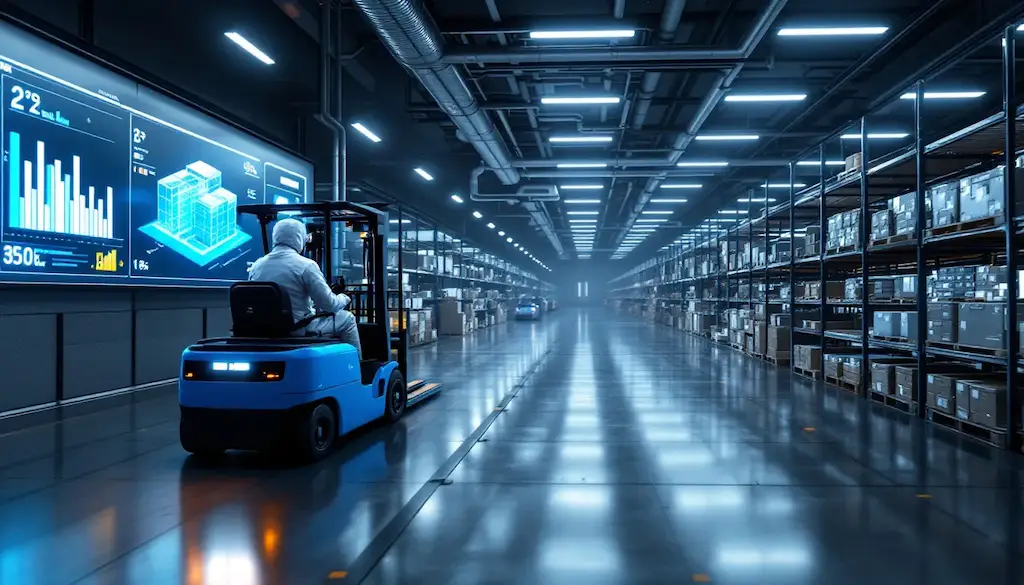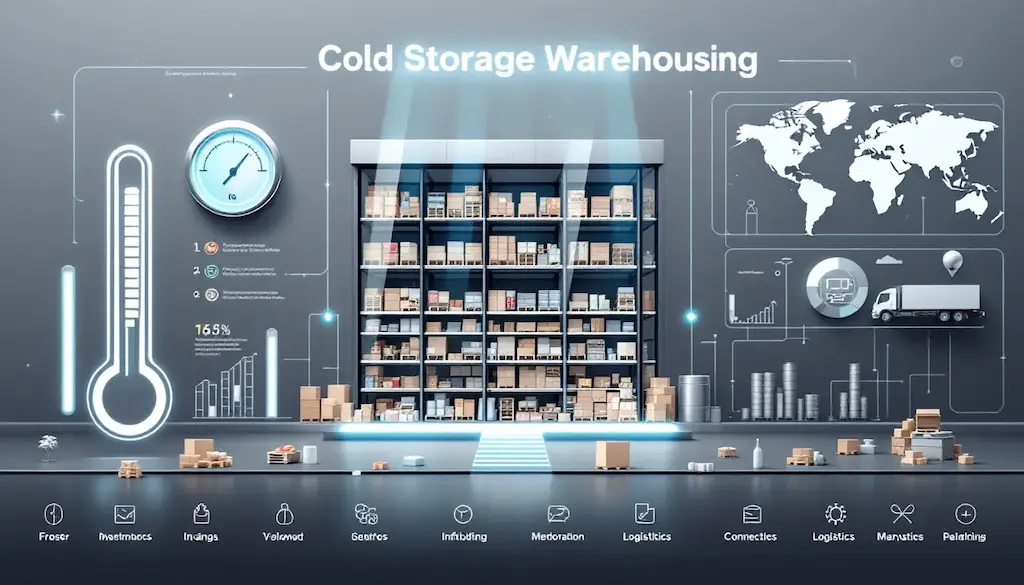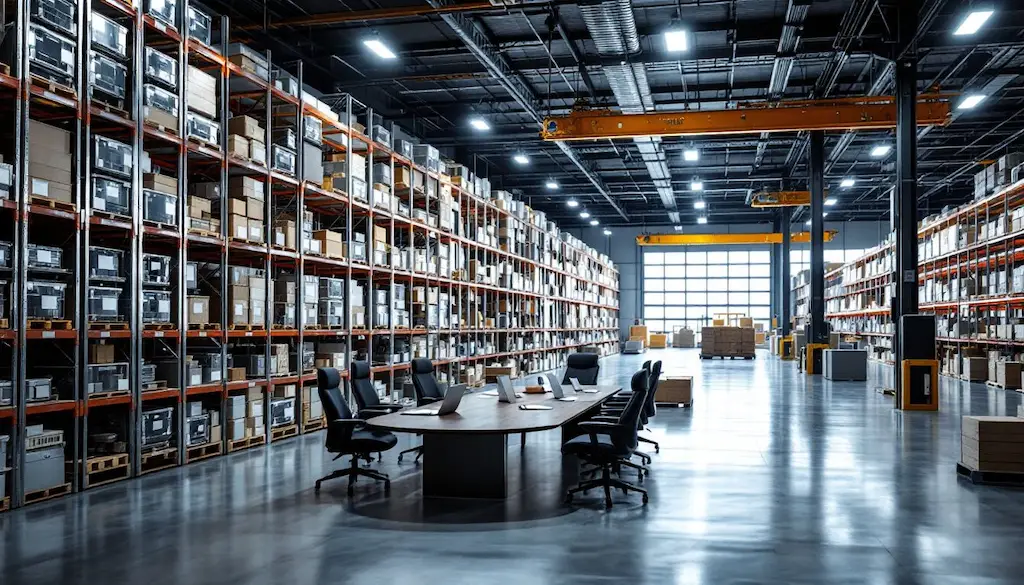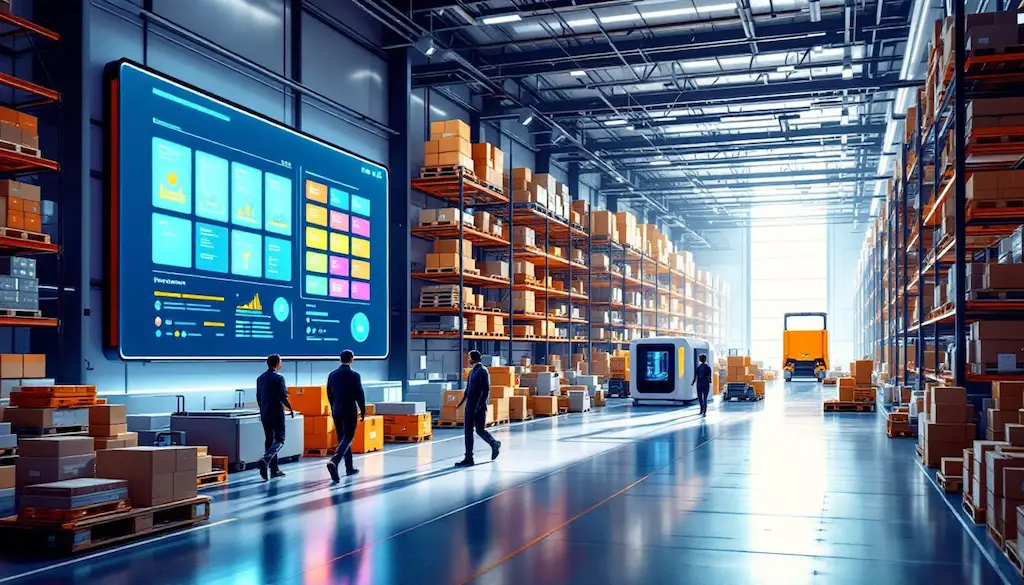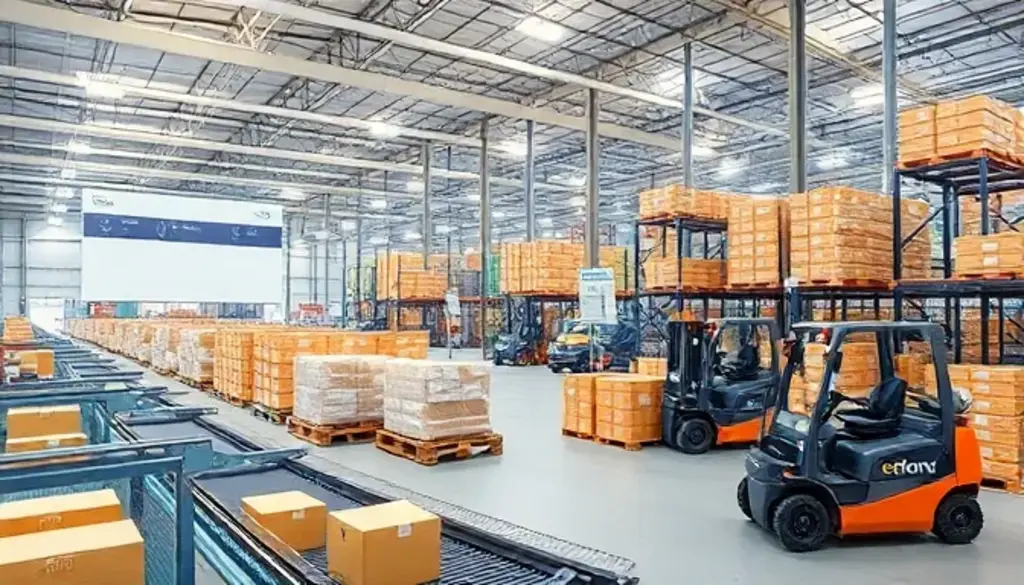
Cold storage warehousing is essential for keeping perishable items fresh and safe. These facilities control temperatures to prevent spoilage. This article explores the key features and benefits of cold storage warehousing and its role in various industries.
Key Takeaways
- Cold storage warehousing is integral for the preservation of temperature-sensitive products across several industries, ensuring product integrity and safety.
- Key features of cold storage facilities include advanced insulation, reliable refrigeration systems, and optimized facility layout to maintain consistent temperatures.
- Emerging trends in the cold storage market, such as automation and energy-efficient technologies are enhancing operational efficiency and sustainability.
Understanding Cold Storage Warehousing
Cold storage warehousing refers to the storing of temperature-sensitive products under controlled conditions to ensure their integrity and safety. Unlike typical warehouses, cold storage facilities are designed to maintain specific temperature ranges, which is essential for preventing product spoilage or degradation.
The primary purpose of cold storage warehouses is to preserve the integrity and freshness of temperature-sensitive goods until they reach their final destination. This involves sophisticated temperature control systems that can handle the complexities of storing perishable items. Maintaining a stable temperature is crucial to avoid product spoilage, which can occur if temperatures fluctuate outside the required range.
Cold storage warehouses are a key link in the cold chain, ensuring that products such as food, pharmaceuticals, and biotechnology items remain safe and effective from production to consumption. The significance of these facilities extends across numerous industries, playing a critical role in preserving product quality and safety in a cold storage warehouse.
Key Features of Cold Storage Facilities
Cold storage warehouses are equipped with several key features to ensure optimal temperature control and product preservation. One of the most critical components is the insulation materials used in the cold storage construction of these facilities. Insulation limits heat transfer between the inside and outside of the warehouse, ensuring consistent temperatures. This is particularly important as it helps maintain the quality of perishable goods.
Refrigeration systems are another vital feature of cold storage facilities. These systems typically include condensers and evaporators, which work together to remove heat from the refrigerant and bring cold air into the storage space. The reliable power supply with backup systems is crucial to prevent product spoilage during power outages, thereby reducing the risk of significant financial losses.
Efficient facility layout design is essential for optimal airflow and temperature distribution. Methods such as HVAC cooling systems and solid insulation are employed to maintain stable temperatures throughout the warehouse. Additionally, backup power systems are indispensable in cold storage to ensure continuous operation and product safety.
These features collectively ensure that cold storage warehouses provide the necessary conditions to preserve temperature-sensitive goods, making them a cornerstone of the cold storage industry.
Types of Cold Storage Warehouses
Various types of cold storage warehouses exist. Each type is designed to accommodate specific temperature and storage needs. The main types include refrigerated, frozen, and climate-controlled warehouses, each catering to different types of products and their specific storage needs.
Properly designed cold storage facilities are essential to handle the diverse requirements of different products, ensuring they do not spoil. Let’s delve into each type to understand their unique characteristics and applications.
Refrigerated Warehouses
Refrigerated warehouses are mainly classified as refrigerated cold storage facilities. They keep temperatures above freezing but below room temperature. These refrigerated containers are crucial for storing fresh produce, dairy products, and other perishable items that require a cool environment to remain fresh.
Typically, the temperature range of a chilled warehouse is between -30° to 70° F. This controlled environment helps extend the shelf life of products by slowing down the growth of bacteria and other microorganisms.
Frozen Warehouses
Frozen warehouses operate within much lower temperature ranges, typically between -10° to -20° F. These facilities are essential for storing products such as ice cream, frozen fruits, and vegetables, which require sub-zero temperatures to maintain their quality.
Ultra-low temperature cold storage, which operates within the range of -4° to -122.8° F, is particularly important for storing items like vaccines and other medical supplies that require extremely cold conditions. Some vaccines, such as the Pfizer-BioNTech, require storage at -70°C to remain effective.
Climate-Controlled Warehouses
Climate-controlled warehouses go beyond just temperature control; they also manage humidity and gas levels. These temperature controlled warehouses are designed to ensure optimal storage conditions for perishable goods, significantly extending their shelf life.
Advanced insulation, specialized refrigeration systems, and comprehensive monitoring equipment are key features of climate-controlled warehouses. These warehouses preserve the quality and longevity of stored products through effective environmental management.
Industries Relying on Cold Storage
Several industries depend heavily on cold storage facilities to maintain the quality and safety of their products. The food and beverage, pharmaceutical, and biotechnology sectors are among the primary users of cold storage warehouses.
The global cold storage market is projected to increase significantly, highlighting the growing reliance on these facilities across different industries. Let’s explore how each sector benefits from cold storage.
Food and Beverage Industry
Cold storage is essential for the food and beverage industry. It helps to maintain the freshness and quality of perishable goods. Cold storage facilities help maintain food safety by keeping items out of temperature ranges that promote bacterial growth. This is crucial for products like dairy, meat, and beverages, which require specific storage conditions to remain safe and consumable.
Pharmaceutical Industry
Cold storage is crucial for the pharmaceutical industry. It ensures the efficacy and safety of temperature-sensitive drugs and vaccines. These products often require storage within a temperature range of 2°C to 8°C to remain effective.
Compliance with regulatory requirements such as Good Distribution Practices (GDP) and Good Manufacturing Practices (GMP) is crucial for cold storage facilities in the pharmaceutical sector. Meeting these standards ensures that pharmaceuticals are stored and transported safely.
Biotechnology and Healthcare
In the biotechnology and healthcare sectors, cold storage is essential for preserving biological samples and temperature-sensitive medical supplies. These samples must remain stable for research and development, making cold storage a critical component in these industries.
Secure cold storage ensures the integrity and availability of medical supplies, which is vital for healthcare systems. This allows for accurate research results and advancements in the field.
Benefits of Cold Storage Warehousing
Cold storage warehouses offer several key benefits, including extended shelf life, reduced waste, and improved supply chain efficiency. These facilities prevent spoilage and ensure products remain safe and consumable through optimal preservation conditions.
One of the significant advantages of cold storage is its ability to reduce food waste. Cold storage facilities enable products to be stored for extended periods without losing quality by maintaining optimal storage conditions. This not only helps in reducing waste but also contributes to cost savings for businesses.
Moreover, cold storage solutions enhance supply chain efficiency by ensuring a stable supply of perishable goods. Industries that rely on consistent product availability benefit from the stability provided by cold storage warehouses, making them an integral part of modern supply chains.
Challenges in Cold Storage Warehousing
Despite its benefits, cold storage warehousing comes with its own set of challenges. These include high energy consumption, space utilization issues, and the need to maintain precise temperature control. Each of these challenges can significantly impact the efficiency and cost-effectiveness of cold storage operations.
Power disruptions and equipment breakdowns can also pose significant risks, as they can lead to temperature fluctuations and product spoilage. Let’s explore these challenges in more detail.
Energy Consumption
Cold storage warehouses typically incur high energy costs, averaging 24.9 kWh per square foot per year. Factors contributing to these high utility bills include cooling systems, automatic doors, and fire safety systems.
Investing in advanced insulation materials and technologies such as LED lighting, high-speed doors, and vapor barriers can enhance energy efficiency. These improvements help reduce energy consumption and operational costs while maintaining optimal storage conditions.
Space Utilization
Optimizing space in cold storage warehouses is a significant challenge. Traditional methods like pallet racking often leave unused space, leading to inefficient space utilization. Expanding storage vertically and using automation can help maximize storage density.
Implementing specific use equipment and pallet-flow systems for fast access can also improve space utilization. These strategies help businesses make the most of their storage capacity, enhancing operational efficiency.
Temperature Fluctuations
Temperature fluctuations can significantly impact the quality of products stored in cold storage warehouses. At cold temperatures, materials may become brittle. This makes them more susceptible to damage. Backup systems, such as liquid nitrogen or carbon dioxide cooling systems, are essential to maintain stable temperatures.
Monitoring systems that include alarms, data logging, and remote temperature control are crucial for preventing temperature fluctuations. These systems help ensure that products remain within the required temperature range, preserving their quality and safety.
Emerging Trends in Cold Storage Warehousing
The cold storage market is experiencing rapid growth, driven by increased global trade and consumer demand for fresh and frozen products. Key trends in the industry include automation, energy-efficient technologies, and blockchain for traceability. These trends are shaping the future of cold storage warehousing, making it more efficient and sustainable.
Let’s explore each of these trends in detail.
Automation and Robotics
Robotics and artificial intelligence are continuously being integrated into cold storage operations to streamline processes and reduce overheads. Technologies such as automated guided vehicles (AGVs), RFID scanners, and Automated Storage and Retrieval Systems (ASRS) are being utilized to improve efficiency.
Automation reduces the need for human workers, lowers injury risk, and boosts productivity, leading to quicker turn times and faster order fulfillment. These systems also enhance space optimization in cold storage warehouses.
Energy-Efficient Technologies
Energy-efficient technologies are becoming increasingly important in cold storage facilities, helping to lower operational costs and support sustainability goals. Technologies such as LED lighting, advanced insulation materials, and renewable energy sources are being adopted to enhance energy efficiency.
While improving energy efficiency often requires substantial upfront investments, the long-term benefits include reduced energy consumption and lower utility bills. These investments make cold storage operations more sustainable and cost-effective in the long run.
Blockchain for Traceability
Blockchain technology is being explored to improve traceability in cold storage supply chains. By providing a transparent and tamper-proof record of product movements and environmental conditions, blockchain enhances accountability and trust among stakeholders.
This technology helps maintain product integrity by ensuring that all parties involved in the supply chain have access to accurate and real-time data. This visibility is crucial for industries that rely on cold storage to preserve the quality and safety of their products.
Tips for Working Safely in Cold Storage Environments
Working in cold storage environments requires specific safety measures to prevent health risks and ensure operational efficiency. Proper clothing is essential; workers should dress in layers with insulated and waterproof boots, gloves, and hats or masks to prevent heat loss.
Training is also crucial for recognizing signs of cold stress and providing first aid when necessary. Employees should be well-versed in maintenance protocols and know how to handle equipment designed for cold environments, such as cold storage-rated forklifts and proper lighting.
Regular breaks are important to mitigate the risk of hypothermia. Ensuring that employees are aware of safety protocols and have access to warm areas for breaks can significantly reduce the risk of cold-related injuries.
Choosing the Right Cold Storage Warehousing Partner
Selecting the right cold storage warehousing partner is crucial for ensuring that your temperature-sensitive products are stored and transported safely. One of the most important factors to consider is the location of the cold storage facility, as it impacts transportation costs and transit times. A strategically located warehouse can help reduce these costs and improve delivery efficiency.
The storage capacity of the warehouse is another critical consideration. The facility must be able to meet your business needs and accommodate seasonal demand fluctuations. Additionally, strong security measures, including surveillance and restricted access, are vital for protecting stored goods.
Value-added services such as palletizing, kitting, and labeling can also enhance the overall efficiency of your supply chain. These services streamline operations and add flexibility, making it easier to manage your inventory and meet customer demands.
How Logimax Optimizes Cold Storage Operations
Managing a cold storage warehouse requires precision, flexibility, and reliability—qualities at the core of Logimax’s Warehouse Management System (WMS). Built with cold storage complexities in mind, Logimax delivers powerful tools to help 3PLs, food and beverage distributors, and other temperature-sensitive industries maintain compliance, maximize efficiency, and protect inventory integrity.
Logimax’s WMS is uniquely positioned to meet the demands of cold storage facilities. Our solution supports real-time inventory tracking, including lot and date control, catch weight management, and temperature zone visibility—ensuring full traceability from dock to door. This is critical for industries like food, pharma, and biotech, where the margin for error is minimal.
Logimax also integrates seamlessly with refrigeration monitoring systems, automated equipment, and ERP platforms, allowing operators to manage workflows, monitor storage conditions, and streamline order processing—all within a single, easy-to-use interface. With robust billing features, Logimax simplifies complex 3PL chargebacks, storage fees, and value-added service billing, helping businesses capture more revenue with less effort.
Whether you’re running a frozen, refrigerated, or climate-controlled facility, Logimax empowers your team with the tools needed to adapt to seasonal fluctuations, handle SKU complexity, and meet evolving customer expectations. Backed by decades of industry expertise, Logimax’s cold storage WMS is a proven solution that scales with your operation—enhancing productivity while reducing waste and downtime.
Summary
Cold storage warehousing plays a vital role in preserving the quality and safety of temperature-sensitive products across various industries. From understanding the key features and types of cold storage warehouses to exploring the benefits and challenges, this guide provides comprehensive insights into the world of cold storage.
Emerging trends such as automation, energy-efficient technologies, and blockchain are shaping the future of the cold storage industry, making it more efficient and sustainable. By choosing the right cold storage warehousing partner and following safety tips, businesses can ensure the integrity of their products while optimizing their supply chain operations.
Ready to modernize your cold storage operations?
Discover how Logimax’s purpose-built WMS can help you maintain product integrity, improve efficiency, and stay ahead of industry demands. Request a demo today to see our cold storage solution in action.
Frequently Asked Questions
What is the main purpose of cold storage warehousing?
The main purpose of cold storage warehousing is to preserve the integrity and freshness of temperature-sensitive goods by maintaining specific temperature ranges, thereby preventing spoilage or degradation.
What are the key features of a cold storage warehouse?
The key features of a cold storage warehouse include advanced insulation materials, efficient refrigeration systems, a reliable power supply with backups, and a facility layout designed for optimal airflow and temperature distribution. These elements are essential for maintaining the integrity of stored products.
Which industries rely heavily on cold storage facilities?
Industries such as food and beverage, pharmaceuticals, and biotechnology heavily rely on cold storage facilities to ensure the quality and safety of their products. Therefore, efficient cold storage is critical for these sectors.
What are the main challenges in cold storage warehousing?
The main challenges in cold storage warehousing are high energy consumption, inefficient space utilization, and the critical need for precise temperature control to prevent product spoilage. Addressing these issues is essential for operational efficiency and product integrity.
How is blockchain technology used in cold storage warehousing?
Blockchain technology enhances cold storage warehousing by offering a transparent and tamper-proof record of product movements and environmental conditions, thereby improving traceability and fostering accountability among stakeholders.

